1. Nahargarh Fort
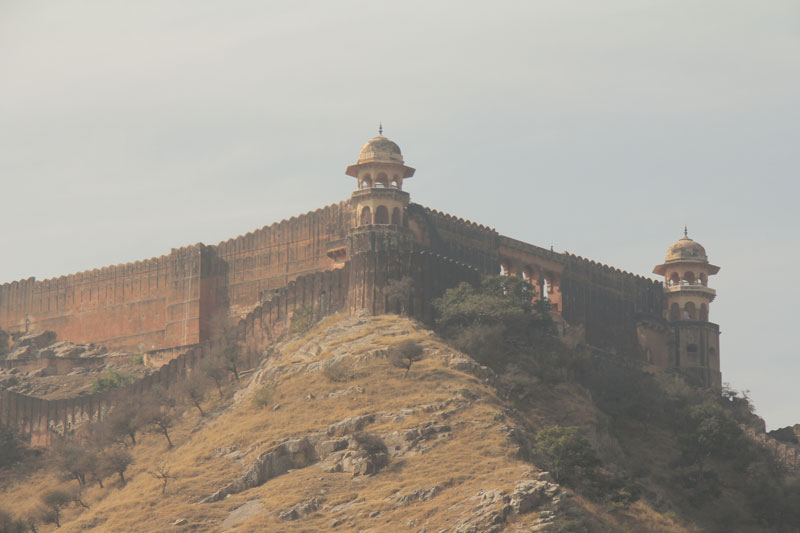 Situated at around 200 meters above sea level and overlooking the Jaipur City, the Nahargarh fort was intended to be a safe haven for the Royal family of Jaipur during enemy invasions. The fortified palace was constructed during the reign of Sawai Jai Singh II in 1734 AD. The palatial fortress is constructed in a typical Rajput style architecture with European influences. The fort was also used as a summer residence for the Royal family for a brief period of time and one can get a marvelous view of Jaipur city from its lookout points. The temple dedicated to Nahar Singh Bhomia, whose spirit haunted the fort and the Madhavendra Bhavan are some of the structures that one shouldn’t miss. For those who want a better view of the surroundings can also visit the RTDC Padao Restaurant located on the highest point and is accessible by paying a sum of INR 50 at the entrance gate. Padao is one of the best vantage points in the fort and one can have snacks and drinks while enjoying the cool breeze and the marvelous view of the city, although the choices in food are very limited. The liquor is offered here at premium rates and is not covered in the entrance fee. Visiting the restaurant during the festival of Diwali is recommended, as one can view the incredible city lights and the fireworks from almost 431 meters above the city of Jaipur.
Situated at around 200 meters above sea level and overlooking the Jaipur City, the Nahargarh fort was intended to be a safe haven for the Royal family of Jaipur during enemy invasions. The fortified palace was constructed during the reign of Sawai Jai Singh II in 1734 AD. The palatial fortress is constructed in a typical Rajput style architecture with European influences. The fort was also used as a summer residence for the Royal family for a brief period of time and one can get a marvelous view of Jaipur city from its lookout points. The temple dedicated to Nahar Singh Bhomia, whose spirit haunted the fort and the Madhavendra Bhavan are some of the structures that one shouldn’t miss. For those who want a better view of the surroundings can also visit the RTDC Padao Restaurant located on the highest point and is accessible by paying a sum of INR 50 at the entrance gate. Padao is one of the best vantage points in the fort and one can have snacks and drinks while enjoying the cool breeze and the marvelous view of the city, although the choices in food are very limited. The liquor is offered here at premium rates and is not covered in the entrance fee. Visiting the restaurant during the festival of Diwali is recommended, as one can view the incredible city lights and the fireworks from almost 431 meters above the city of Jaipur.
- Opening Timings – 10:00 am to 6:00 pm all days (One could visit the place any time, but the entry to the fort will be restricted.)
- Padao Restaurant – 3:00 pm to 10:00 pm all days
- Entrance Fee
- Indians: INR 20
- Foreigners: INR 50
- Indian Students: INR 5
- Foreigner Students: INR 25
- Camera Fee
- Indians: INR 10
- Foreigners: INR 30
Photo by Piyush Kumar, CC BY 2.0
2. Jaigarh Fort
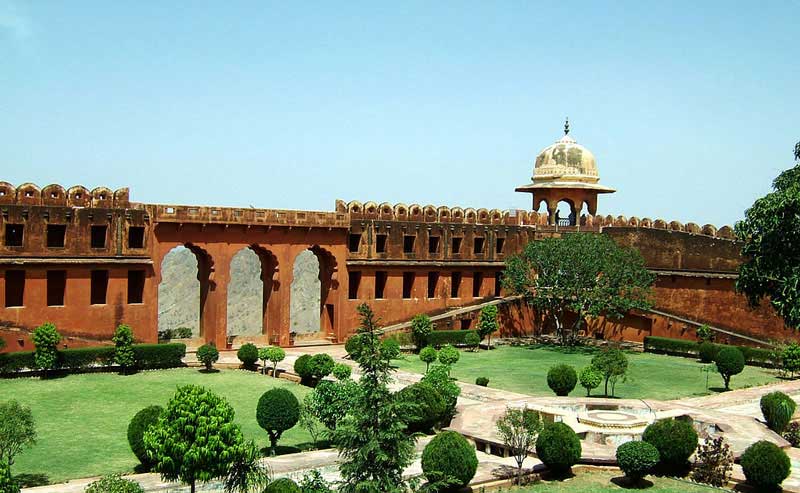 Situated on a hillock known by the locals as ‘Cheel ka Teela’ (Hill of Eagles), Jaigarh was the defense fortress and cannon foundry of the Maharajas of Jaipur and the Mughals. The fort was constructed by Maharaja Sawai Jai Singh of Jaipur in 1726. The main attraction in this fort is the world’s largest cannon on wheels, named Jaivana, which was molded in the same cannon foundry. Jaivana was test-fired only once and never used in actual combat as the rulers of Jaipur had diplomatic relations with both Mughals and the British. One could also take their car straight to the point where the cannon is stationed, to avoid a long walk. Apart from the massive cannon, the fort also houses an armory, a museum, palatial chambers and a well maintained Persian styled garden known as the ‘Charbagh Garden’. Two temples named the Kal Bhairav temple and Ram Harihar Temple are also located within the fortress walls and are visited by thousands of devotees each year. The fortress walls also double as fortifications and canals, which were used for harvesting the rainwater in the older days. The Diwa Burj, a 7 stories tall watchtower is also a popular attraction and provides some enchanting views of the surrounding valleys and the city of Jaipur.
Situated on a hillock known by the locals as ‘Cheel ka Teela’ (Hill of Eagles), Jaigarh was the defense fortress and cannon foundry of the Maharajas of Jaipur and the Mughals. The fort was constructed by Maharaja Sawai Jai Singh of Jaipur in 1726. The main attraction in this fort is the world’s largest cannon on wheels, named Jaivana, which was molded in the same cannon foundry. Jaivana was test-fired only once and never used in actual combat as the rulers of Jaipur had diplomatic relations with both Mughals and the British. One could also take their car straight to the point where the cannon is stationed, to avoid a long walk. Apart from the massive cannon, the fort also houses an armory, a museum, palatial chambers and a well maintained Persian styled garden known as the ‘Charbagh Garden’. Two temples named the Kal Bhairav temple and Ram Harihar Temple are also located within the fortress walls and are visited by thousands of devotees each year. The fortress walls also double as fortifications and canals, which were used for harvesting the rainwater in the older days. The Diwa Burj, a 7 stories tall watchtower is also a popular attraction and provides some enchanting views of the surrounding valleys and the city of Jaipur.
- Opening Timings – 9:00 am to 5:00 pm all days
- Entrance Fee
- Indian: INR 35
- Foreigners: INR 85
- Vehicle Entry Charge: INR 50
- Camera Fee
- INR 50 and INR 200 for Video Camera
Photo by Matthew Laird Acred, CC BY-SA 3.0
3. Amber Fort
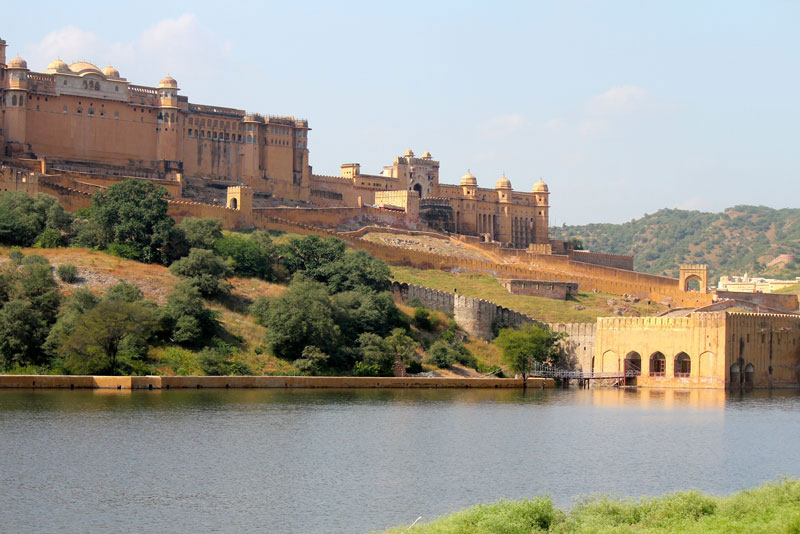 The prized architectural jewel of Jaipur, the Amber fort is located in the medieval town of Amer, which is at a short distance of 10 kilometers from Jaipur. The fort was said to have been constructed by the Rajput King Raja Man Singh of Amer in the late 16th century and expanded by Raja Jai Singh I, before the capital was shifted to Jaipur. The fort is impressively well preserved and boasts of a striking architecture and combines different styles from Hindu, European and Persian building designs.
The prized architectural jewel of Jaipur, the Amber fort is located in the medieval town of Amer, which is at a short distance of 10 kilometers from Jaipur. The fort was said to have been constructed by the Rajput King Raja Man Singh of Amer in the late 16th century and expanded by Raja Jai Singh I, before the capital was shifted to Jaipur. The fort is impressively well preserved and boasts of a striking architecture and combines different styles from Hindu, European and Persian building designs.
Most of the structures in the fort feature the signature Chatri and is decorated with intricate carvings and stone lattice work known as ‘jalis’. The entry to the base of this grand citadel is marked by the manmade Maota Lake that features an eye catching flower garden known as Kesar Kyari (Saffron Orchard), built in a typical Persian style. The fortress walls are made of red sandstone, with marble Chhatris and painted in a yellowish amber color.
The palatial structure itself is divided into 4 sections with individual entrances and central courtyards. The main entrance is named the Suraj Pol and is located towards the east and leads straight to the main courtyard named ‘Jaleb Chowk’. Entering the fort on foot or Elephant, you will enter through the Suraj Pol gate, which directly leads to Jaleb Chowk. Entering the fort by car will take you through Chand Pol gate, located on the opposite side of Jaleb Chowk, but near the Shila Mata Temple.
Light and Sound Show – If you want to know more about the history of Amer and Jaipur, then it is important that you visit this show. Organized every evening at the Amer fort complex, this light and sound show is conducted in both Hindi and English at the Kesar Kyari garden. The show lasts for 50 minutes and provides a brief yet enchanting look at the colorful culture of Jaipur.
Amber by Night – With a view of promoting night time tourism in Jaipur, the government has recently inaugurated the “Amber by Night”. This involves a brief tour of some of the most exquisite areas of the fort such as Sheesh Mahal, Jaleb Chowk, Mansingh Mahal and Diwan-e-Aam. These areas were chosen, as they appear to be totally different during the night time.
Entry Timings
- Day– 8:30 am to 5:30 pm
- Night – 7:00 pm to 10:00 pm (Only Jaleb Chowk, Diwan-e-Aam, Mansingh Mahal and Sheesh Mahal are open for viewing)
- Light and Sound Show – 7:30 pm (Hindi), 8:30 pm (English)
Entry Fee
- Day
- Indian: INR 25
- Foreigners: INR 200
- Indian Students: INR 10
- Foreign Students: INR 100
- Night
- Indian: INR 100
- Foreigners: INR 400
- Light and Sound Show
- Hindi: INR 100
- English: INR 200
From Amber Base to the Top
When visiting the fort, you can choose to go all the way from the base to the top by foot or you can hire a jeep or an elephant. Jeep rides are available all day. Elephant rides however, start from 8.00 am and are only available till 11.00 am. The return trip only happens during the evening, before the fort is closed for visitors so it is better to take a jeep on your way back.
Jeep Ride to the Fort
- Timings: 8:00 am to 6:00 pm all days
- Fee: INR 150/Person (One Way)
Elephant Ride to the Fort
Timings
- Morning –7.00 am to 11.00 am summers, 7.00 am till 12.00 pm Winters
- Evening –3:30 pm till 5:30 pm
- Fee: INR 900 for 2 People (One Way)
Important: If one is good at driving, they can also take their personal car to the parking spot inside the fort and save all the additional fees. You might have to pay the parking fee, which will not be more than INR 30-40. If you have hired a cab to Amer, the driver will take you right to the parking spot inside the fort.
Listed Below Are the Places You Should Definitely Visit In Amer
-
Jaleb Chowk
Is said to be the main gathering place for the soldiers. During the reign of Raja Jai Singh, Jaleb Chowk was used for several parades by the Maharaja’s personal bodyguards. The word ‘Jaleb Chowk’ is a Persian word, which translates to a place where soldiers assemble. The structures located at the upper levels were used as residential quarters by the guards with the horse stables located right next to Jaleb Chowk.
-
The Diwan-I-Aam
Diwan-I-Aam is another interesting area in Amer, which was the public audience hall during the older times. The structure is marked by a raised platform with a roof that is supported by 27 pillars. Each of the pillars is intricately carved and decorated with elephant motifs and frescoes.
-
The Shila Devi temple
Shila Devi Temple is dedicated to an incarnation of the Hindu goddess Shakti. Shila Devi is said to be the patron deity of the Rajput rulers of Jaipur and has a very interesting story related to its consecration within the fort. The temple’s entrance is marked by an intricately carved double door, which is covered in silver sheet and 2 lion sculptures made of pure silver can be found beside the chief deity of the temple. One can also see a beautiful carving of Lord Ganesha near the entrance that is carved from a single piece of coral. The idol of Shila Mata is said to be carved from a single block of stone, which is also linked to the story of Lord Krishna.
-
Sukh Niwas
Sukh Niwas was said to be the resting quarters of the Royal family, where the Maharaja used to spend time with the queens and the mistresses. The place is an architectural marvel for its time as it contained a specialized water canal that kept the enclosure cool during the day time and can be termed as ‘Medieval Air-Conditioning’.
-
Sheesh Mahal
Sheesh Mahal or the Glass Palace is one of the most astounding structures in the fort. The interior walls of this picturesque enclosure are marvelously decorated with studded glasswork and colorful murals made with foil. In low light conditions, just two candles are enough to illuminate the room as the light is reflected by the several mirrors on the walls and ceilings.
-
Man Singh I’s Palace
Man Singh I’s Palace is said to be one of the oldest parts in the Amber fort. Like its name suggests, the structure was built by Raja Man Singh I of Amer and is considered to be the main residential place for the royal family. The exterior and interior walls of this structure are intricately designed with frescoes, carvings and colorful paintings that reflect the grandeur of the Rajputs of Jaipur. The central structure is also known as the ‘Baradari’ and has an ornamental roof supported by 12 pillars.
Photo by Ross Huggett, CC BY 2.0
4. City Palace
 Located in the center of the walled city of Jaipur, the city palace was built by Sawai Jai Singh II in the 18th century and it became a residence for the Maharajas of Jaipur ever since. The palatial complex contains several gardens, palaces, temples and a museum, all built in a unique mix of different architectural styles. The traditional Hindu Rajput architecture, with hints of Mughal and European styles makes this palace a must visit for history buffs and for those who want to experience the grandeur of the Royal Family of Jaipur.
Located in the center of the walled city of Jaipur, the city palace was built by Sawai Jai Singh II in the 18th century and it became a residence for the Maharajas of Jaipur ever since. The palatial complex contains several gardens, palaces, temples and a museum, all built in a unique mix of different architectural styles. The traditional Hindu Rajput architecture, with hints of Mughal and European styles makes this palace a must visit for history buffs and for those who want to experience the grandeur of the Royal Family of Jaipur.
The layout of the palace was designed according to the ancient principles of Vastu Shastra and yet is very urban in its architecture. There are a total of 4 gates to the city palace namely, Tripolia Gate, Virendra Pol, Udai Pol and Atish Pol. The Tripolia Gate leads to the residential quarters of the palace, which is still used by the erstwhile Royal family of Jaipur and hence, the entry is restricted. Visitors can enter through the remaining three gates, which are all designed in a marvelous culmination of Indian and Persian architecture.
Entry Timings
9:30 am to 5:00 pm
Entry Fees
- Indian Visitors
- Adults: INR 75
- Children: INR 35 between 5 -12 years
- Student and Defense Personnel: INR 40
- Foreign Tourists
- Adults: INR 300
- Children: INR 200 between 5-12 years and students
Listed below are the must visit Places Inside the city palace complex
-
Mubarak Mahal
The word ‘Mubarak’ translates to auspicious and is a splendid mix of different architectural styles. The Mubarak Mahal was constructed by Maharaja Madho Singh II around the late 19th century. Its construction was completed in early 20th century and is considered to be one of the most beautifully designed 20th century buildings in the world. The structure is made from carved dolomite or Jeypore marble and contains several ornamental designs on the walls, ceilings and balconies that reflect the cross between Hindu and Mughal designs. Used during the older days to welcome the foreign guests of the Maharajas, Mubarak Mahal is currently used as a textile museum. One can see the different royal costumes with several exquisite textiles such as Sanganeri prints and embroidered shawls. The main attraction in this museum remains the hefty clothes worn by the hulking Maharaja Madho Singh II.
-
Chandra Mahal
Located towards the western end of the complex, the Chandra Mahal is a 7 storied building, which is still used as a residence by the Royal Family. The building can be entered via the amazingly designed peacock gate and only the ground floor is open for visitors as it houses a museum. One can also see the quarter and a half flag (a royal sign of the Maharajas of Jaipur) when the King is at his residence.
-
Maharani Palace
Although this building has currently been converted to a museum, it was originally known as the Queen’s quarters. The museum contains several arms and weapons used by the Rajputs through their various battles in the 15th century. The structure of the palace is essentially Hindu with Islamic style frescoes on the ceilings, which are preserved with jewel dust. Several daggers and swords, including the scissor dagger and pistol swords are displayed in this museum. The ceilings of the palace are inlaid with fine mirror work and gold leaf, which often leave the visitors astonished and awestruck.
-
Diwan-i-Khas
The Sanskrit name of this courtyard is Sarvatobhadra and it served as the private audience hall for the Maharajas of Jaipur. The Kings would conduct all their formal meetings with ministers and ambassadors in the Diwan-i-Khas, making it a place of high importance. The structure is again designed with signature Hindu and Mughal architectural influences and built in pink and white marble. The structure also houses two largest sterling silver vessels in the world. These vessels were cast from melted silver coins and were used by Madho Singh II to store water from the Ganges during his trip to England in the year 1901.
-
Diwan-I-Aam
Used by the Maharajas to listen to the public opinions and grievances, the Diwan-i-Aam is currently used as an art gallery. The strikingly colorful ceiling and the ornamental design of the building is a marvel in itself. In this galley are some of the most exquisite works of art, miniature paintings from Rajasthan, Persia and the Mughal artisans, and several handwritten copies of Hindu scriptures such as the Bhagwad Gita. One can also have a look at the Maharaja’s throne called the Takht-e-Rawal, which could also be mounted on the back of an Elephant.
-
Bhaggi Khana
The name Bhaggi Khana translates to carriage museum and contains an exquisite collection of carriages and palanquins used by the royal family. One can also find a special carriage presented by the Prince of Wales in 1876 during his visit to Jaipur (this was the same time the city was painted pink). The miniature chariot was used to transport the religious idols during various Hindu festivals and a special palanquin designed for the royal priests.
Photo by Richard Moross, CC BY 2.0
5. Hawa Mahal
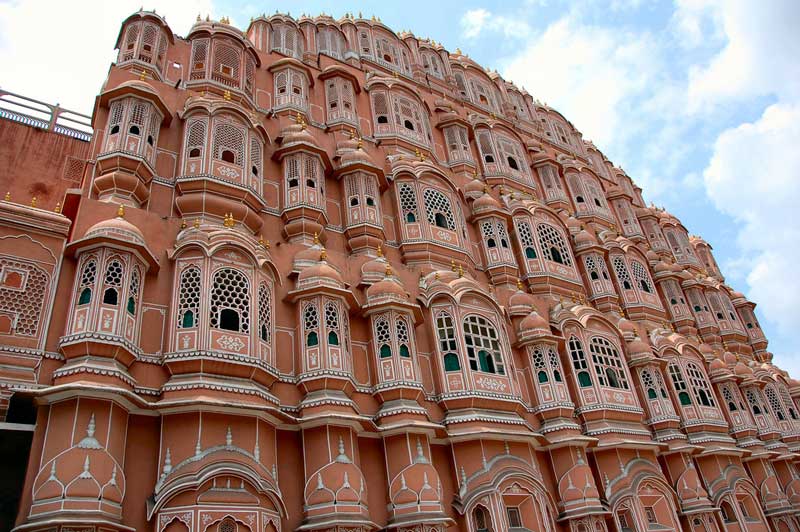 The name Hawa Mahal, literally translates to the Palace of the Winds, and is a marvelous structure built in red and pink sandstone. The building is located at the end of the City Palace complex and is linked to the women’s residence, which was used by the Royal women during the old days. The building was commissioned by Sawai Pratap Singh and was designed to resemble the crown of Lord Krishna. It is considered to be one of the prime examples of Rajput style architecture in Jaipur and features a total 953 ornamental windows known as Jharokhas. The windows are all decorated with latticed screens, which allowed cool breeze to enter the building. The front entry to the building is however closed and visitors must enter through an alternative gateway from the side.
The name Hawa Mahal, literally translates to the Palace of the Winds, and is a marvelous structure built in red and pink sandstone. The building is located at the end of the City Palace complex and is linked to the women’s residence, which was used by the Royal women during the old days. The building was commissioned by Sawai Pratap Singh and was designed to resemble the crown of Lord Krishna. It is considered to be one of the prime examples of Rajput style architecture in Jaipur and features a total 953 ornamental windows known as Jharokhas. The windows are all decorated with latticed screens, which allowed cool breeze to enter the building. The front entry to the building is however closed and visitors must enter through an alternative gateway from the side.
Entry Timings
9:30 am – 4:30 pm
Entry Fees
INR 5 (Indians and Foreigners)
Photo by Russ Bowling, CC BY 2.0
6. Govind Dev Ji Temple
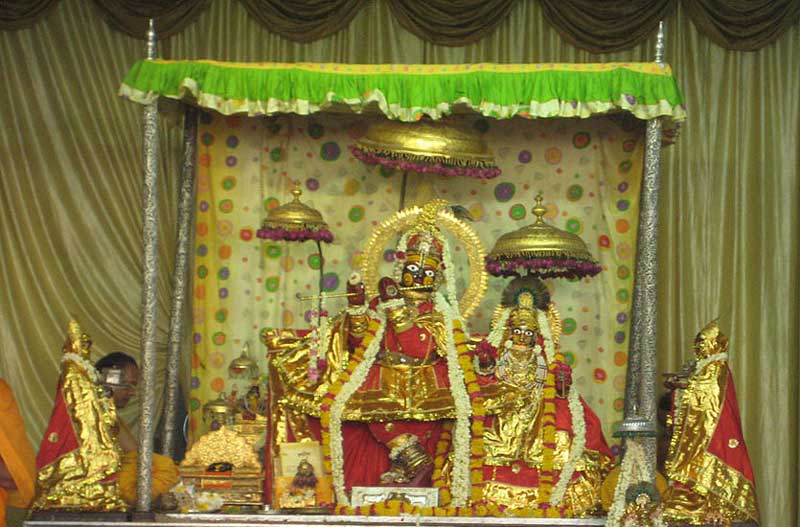 The Temple was built during the 18th century by Sawai Pratap Singh II of Jaipur and also included a garden with a manmade lake (lake is not in a very good condition and shouldn’t be visited). The prime deity of the temple is Lord Govind Dev Ji, which is considered to be the exact image of Lord Krishna. The idol was brought here by Sawai Jai Singh II from Vrindavan to protect it from the religiously fanatic Emperor Aurangzeb. The idol can only be viewed at 7 times during the day when it is unveiled for Aartis. The temple can be visited any time during the day and closes at 9.30 pm. During the festival of Janmashtami, the temple can be a little over crowded and exploring the place can be a little difficult. Located at the backside of the temple complex is also a marvelous garden with a shrine dedicated to the monkey god Lord Hanuman. There is also an open cage with several rhesus macaques, right next to the Hanuman temple where visitors offer fruits and nuts to the monkeys.
The Temple was built during the 18th century by Sawai Pratap Singh II of Jaipur and also included a garden with a manmade lake (lake is not in a very good condition and shouldn’t be visited). The prime deity of the temple is Lord Govind Dev Ji, which is considered to be the exact image of Lord Krishna. The idol was brought here by Sawai Jai Singh II from Vrindavan to protect it from the religiously fanatic Emperor Aurangzeb. The idol can only be viewed at 7 times during the day when it is unveiled for Aartis. The temple can be visited any time during the day and closes at 9.30 pm. During the festival of Janmashtami, the temple can be a little over crowded and exploring the place can be a little difficult. Located at the backside of the temple complex is also a marvelous garden with a shrine dedicated to the monkey god Lord Hanuman. There is also an open cage with several rhesus macaques, right next to the Hanuman temple where visitors offer fruits and nuts to the monkeys.
Aarti Timings
- Mangala Aarti – 4:30 am to 5:00 am
- Dhoop Aarti– 7:30 am to 8:45 am
- Sringar Aarti– 9:30 am to 10:15 am
- Rajbhog Aarti– 11:00 am to 11:30 am
- Gwal Aarti– 5:45 pm to 6:15 pm
- Sandhya Aarti–6:45 pm – 8:00 pm
- Shayan Aarti– 9:00 pm – 9:30 pm
Photo by Sameergoyal, CC BY-SA 3.0
7. Jal Mahal
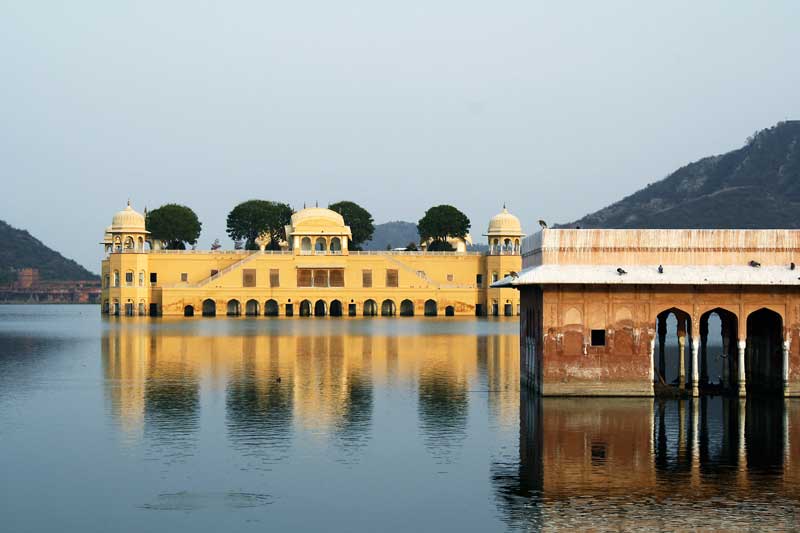 The name Jal Mahal translates to ‘Water Palace’ in Hindi and refers to an 18th century palace constructed during the reign of Sawai Jai Singh II. The palace is set in the heart of the Man Sagar Lake, which is surrounded by the picturesque hills of the Aravali Range. The building started as a simple dam to store water during the 17th century and was later expanded into a palatial structure. Jal Mahal is also in close proximity to other monuments like Amer fort, Kanak Vrindavan, Kanak Ghati and Gaitore. Although the palace is not open for visitors currently and there are no boat rides available to reach the palace. The kilometer long promenade in front of the lake is a great place to enjoy the views during the mornings and evenings.
The name Jal Mahal translates to ‘Water Palace’ in Hindi and refers to an 18th century palace constructed during the reign of Sawai Jai Singh II. The palace is set in the heart of the Man Sagar Lake, which is surrounded by the picturesque hills of the Aravali Range. The building started as a simple dam to store water during the 17th century and was later expanded into a palatial structure. Jal Mahal is also in close proximity to other monuments like Amer fort, Kanak Vrindavan, Kanak Ghati and Gaitore. Although the palace is not open for visitors currently and there are no boat rides available to reach the palace. The kilometer long promenade in front of the lake is a great place to enjoy the views during the mornings and evenings.
The palace itself is a marvelous example of various Indian and Islamic architectural styles brought together and features the traditional Rajput Chhatris on its 4 corners. The central chhatri in the middle is a rectangular one, much akin to that of Bengali Hindu structures. As the palace is located on route to the Amer Fort, it becomes an essential rest stop for the tourists, who can enjoy a relaxing evening here. One can also enjoy a plethora of activities such as Elephant Rides, Photography, and enchanting palace lights after sunset. Visiting during the winters can also be a great way to photograph some rare species of migratory birds. Visitors can also dine at some of the traditional Rajasthani restaurants located nearby.
8. Albert Hall Museum
 Built during the reign of Maharaja Ram Singh II of Jaipur, the Albert Hall museum was designed by the British officer and engineer Sir Samuel Swinton Jacob. The building was constructed as a residence of Albert Edward (King Edward VII), the Prince of Wales during his visit to Jaipur. Post his visit and departure, Maharaja Ram Singh II wanted to use the building as a town hall but it was finally converted to an art museum to promote and inspire local artists, during the reign of his successors. The building itself is a spectacle, as it seamlessly combines the Indian and European architectural style, while maintaining the Rajput aesthetics with ornamental Chhatris.
Built during the reign of Maharaja Ram Singh II of Jaipur, the Albert Hall museum was designed by the British officer and engineer Sir Samuel Swinton Jacob. The building was constructed as a residence of Albert Edward (King Edward VII), the Prince of Wales during his visit to Jaipur. Post his visit and departure, Maharaja Ram Singh II wanted to use the building as a town hall but it was finally converted to an art museum to promote and inspire local artists, during the reign of his successors. The building itself is a spectacle, as it seamlessly combines the Indian and European architectural style, while maintaining the Rajput aesthetics with ornamental Chhatris.
Set right outside the main entrance of the Pink City, the museum is located in a beautifully designed public park known as Ram Niwas Bag. The various galleries of the museum includes several items and artifacts such as sculptures, jewelry, pottery, garments and textiles, furniture, coins, weapons and armor, miniature paintings, portraits, carpets and several marble and clay artifacts from all over the country and aboard. One of the prized possessions in the Museum, are the preserved remains of a 2300-years old Egyptian mummy with an ornamental sarcophagus, which was brought from Cairo in 1887.
Entry Timings
9:00 am to 5:00 pm all days except Holi and on Mondays (April – September) and Tuesdays (October – March).
Entry Fees
- Indian Visitor: INR 20
- Indian Students: INR 10
- Foreign Visitor: INR 150
- Foreign Students: INR 75
Free Entry (only during the following dates)
- Rajasthan Day – 30th March
- World Heritage Day – 18th April
- World Tourism Day – 27th September
Audio Guide Fees
- Indian Visitors: INR 90
- Foreign Visitors: INR 150
Photo by Abhinav Soni, CC BY-SA 3.0
9. Jantar Mantar Observatory
 Built by the legendary Sawai Jai Singh II, the Jantar Mantar is the largest of the 5 other such observatories built in India during the 18th century. The designs were based off the ancient Hindu astronomical traditions mentioned in the Vedas and Vedangas. This is also the largest non-telescope observatory in the world, with all its instruments fully functional. The structures were built mostly with sandstone and marble and the instruments allowed deployment of 3 Coordinate systems of the 5 celestial coordinate systems in Astronomy. The Jantar Mantar is located right next to the majestic City Palace and features a total of 19 architectural instruments that allowed astronomical positions to be viewed with the naked eye. The complex also features the world’s largest stone masonry sundial with a massive gnomon that is almost 23 meters high and can also predict significant changes in the weather. Prakash Yantra, Great Ram Yantra, Narivalaya Yantra, Dhruva Yantra and Rashivalayas Yantra are the prime attractions. The site is also listed among the UNESCO World Heritage sites and remains a sought after attraction in the city.
Built by the legendary Sawai Jai Singh II, the Jantar Mantar is the largest of the 5 other such observatories built in India during the 18th century. The designs were based off the ancient Hindu astronomical traditions mentioned in the Vedas and Vedangas. This is also the largest non-telescope observatory in the world, with all its instruments fully functional. The structures were built mostly with sandstone and marble and the instruments allowed deployment of 3 Coordinate systems of the 5 celestial coordinate systems in Astronomy. The Jantar Mantar is located right next to the majestic City Palace and features a total of 19 architectural instruments that allowed astronomical positions to be viewed with the naked eye. The complex also features the world’s largest stone masonry sundial with a massive gnomon that is almost 23 meters high and can also predict significant changes in the weather. Prakash Yantra, Great Ram Yantra, Narivalaya Yantra, Dhruva Yantra and Rashivalayas Yantra are the prime attractions. The site is also listed among the UNESCO World Heritage sites and remains a sought after attraction in the city.
Entry Timings
9:00 am to 5:00 pm all days
Entry Fees
- Indian Visitors: INR 40
- Indian Students: INR 15
- Foreign Visitors: INR 200
- Foreign Students: INR 100
Photo by McKay Savage, CC BY 2.0
10. Galta Ji
 Located at a short distance of approximately 10 kilometers from Jaipur, Galta Ji or Galwar Bagh is a famous Hindu pilgrimage site dedicated to the Vaishnava sect. The complex is named after the Hindu saint Galav who lived and meditated at this place in the ancient times. It is believed that his meditation and penance was rewarded when the holy Ganges appeared at the site from the mouth of the Gaumukh located in the precincts of the temple. Believing the water to be from the Holy Ganges, the temple contains several ponds and step wells, which are used by the pilgrims and the devotees. Although the site is believed to have existed since Satya Yuga (an ancient period in the Hindu scriptures), the temples were constructed during the reign of Sawai Jai Singh II in the 1800s. Most temples in this complex are built with a signature Hindu Rajput style and feature chhatris and several natural springs. The main pond known as the Galta ji Kund, which never dried out even in the harshest of desert heat, is a major attraction here. It is also known by the locals as the monkey temple due to the thriving population of the rhesus macaques that live here. The temple is open all days including the weekends and can be visited during any time of the day. However, it is better to avoid visiting after sunset as the place is a little secluded from the city and might get a little unsafe for lonely excursions.
Located at a short distance of approximately 10 kilometers from Jaipur, Galta Ji or Galwar Bagh is a famous Hindu pilgrimage site dedicated to the Vaishnava sect. The complex is named after the Hindu saint Galav who lived and meditated at this place in the ancient times. It is believed that his meditation and penance was rewarded when the holy Ganges appeared at the site from the mouth of the Gaumukh located in the precincts of the temple. Believing the water to be from the Holy Ganges, the temple contains several ponds and step wells, which are used by the pilgrims and the devotees. Although the site is believed to have existed since Satya Yuga (an ancient period in the Hindu scriptures), the temples were constructed during the reign of Sawai Jai Singh II in the 1800s. Most temples in this complex are built with a signature Hindu Rajput style and feature chhatris and several natural springs. The main pond known as the Galta ji Kund, which never dried out even in the harshest of desert heat, is a major attraction here. It is also known by the locals as the monkey temple due to the thriving population of the rhesus macaques that live here. The temple is open all days including the weekends and can be visited during any time of the day. However, it is better to avoid visiting after sunset as the place is a little secluded from the city and might get a little unsafe for lonely excursions.
Photo by Yiqun Ding, CC BY-ND 2.0
11. Birla Mandir
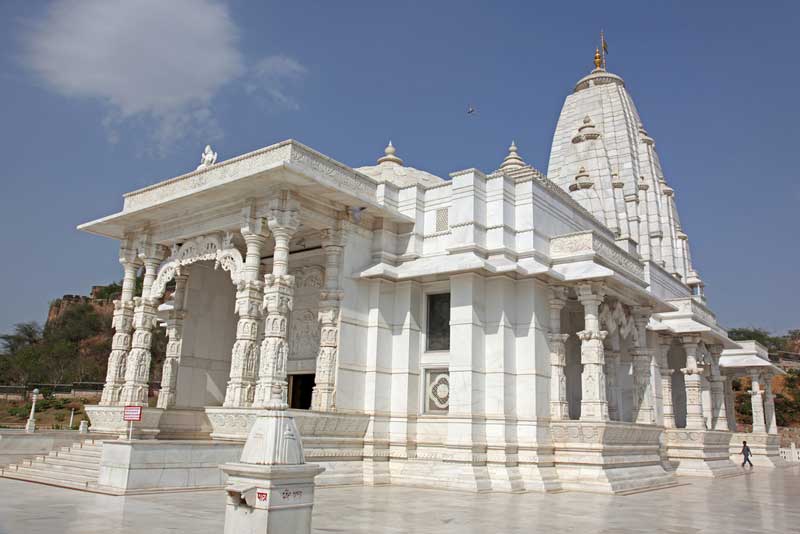 Built in 1988, The Birla Mandir is dedicated to the Hindu deities, goddess Lakshmi and Lord Vishnu. The temple is located at the foot of the Moti Doongri fort and in close proximity to the famous Ganesh Mandir at Moti Doongri. The temple was built by the B.M. Birla foundation, which is credited with building other similar temples in different cities like Delhi, Gwalior, Kolkata and Patna etc. The temple in Jaipur however, seems to be of special importance at it is built purely with white marble, in a typical Hindu temple architecture. The main deity of the temple is Lord Vishnu and Goddess Lakshmi with several idols of Hindu gods and goddesses with several engravings of Hindu scriptures and quotes from the Bhagwad Gita. Idols of several icons from other regions such as Christ, Buddha, Confucius and Socrates etc. are also placed in the temple, exemplifying the cultural oneness of the people of Jaipur. Apart from the religious imagery, the precincts of Birla Mandir also have a well maintained garden with extremely clean surroundings. As the entry to the temple is totally free of charge, it is a great place to spend a relaxing evening amidst the melodious chants from the temple.
Built in 1988, The Birla Mandir is dedicated to the Hindu deities, goddess Lakshmi and Lord Vishnu. The temple is located at the foot of the Moti Doongri fort and in close proximity to the famous Ganesh Mandir at Moti Doongri. The temple was built by the B.M. Birla foundation, which is credited with building other similar temples in different cities like Delhi, Gwalior, Kolkata and Patna etc. The temple in Jaipur however, seems to be of special importance at it is built purely with white marble, in a typical Hindu temple architecture. The main deity of the temple is Lord Vishnu and Goddess Lakshmi with several idols of Hindu gods and goddesses with several engravings of Hindu scriptures and quotes from the Bhagwad Gita. Idols of several icons from other regions such as Christ, Buddha, Confucius and Socrates etc. are also placed in the temple, exemplifying the cultural oneness of the people of Jaipur. Apart from the religious imagery, the precincts of Birla Mandir also have a well maintained garden with extremely clean surroundings. As the entry to the temple is totally free of charge, it is a great place to spend a relaxing evening amidst the melodious chants from the temple.
Entry Timings
8.00 am – 12.00 pm
4.00 pm – 8.00 pm
Photo by Chris Brown, CC BY-SA 2.0
12. Gaitore
 Known to be the final resting place for the Kachwaha Rajputs, Gaitore was the royal cremation ground of the rulers of Jaipur and Amer. The place is located at a distance of approximately 15 kilometers from Jaipur and features several ornamental chhatris that function as cenotaphs to the great Kings. Most of the chhatris in Gaitore are made of sandstone and marble and are intricately designed with signature rajasthani architecture. The Chhatris of great rulers such as Jai Singh II and Madho Singh II are must visit attractions on your excursion to Gaitore.
Known to be the final resting place for the Kachwaha Rajputs, Gaitore was the royal cremation ground of the rulers of Jaipur and Amer. The place is located at a distance of approximately 15 kilometers from Jaipur and features several ornamental chhatris that function as cenotaphs to the great Kings. Most of the chhatris in Gaitore are made of sandstone and marble and are intricately designed with signature rajasthani architecture. The Chhatris of great rulers such as Jai Singh II and Madho Singh II are must visit attractions on your excursion to Gaitore.
Photo by IPS Pahwa, CC BY-SA 3.0
13. Pink City Bazaars
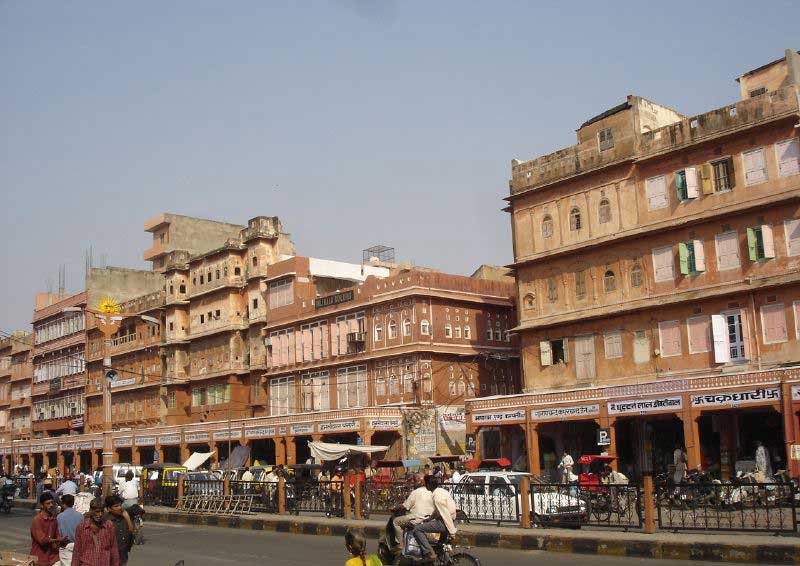 A trip to the Pink City would be totally incomplete without experiencing its grand Bazaars that make up for the huge tourist crowds that the city attracts. A majority of the bazaars are located inside the pink city walls and offer a plethora of articles such as clothes, footwear, handicrafts, decorative items, utensils and furniture etc. Listed below are the various shopping districts in the pink city and the items that can be bought.
A trip to the Pink City would be totally incomplete without experiencing its grand Bazaars that make up for the huge tourist crowds that the city attracts. A majority of the bazaars are located inside the pink city walls and offer a plethora of articles such as clothes, footwear, handicrafts, decorative items, utensils and furniture etc. Listed below are the various shopping districts in the pink city and the items that can be bought.
- Bapu Bazaar – Textiles and Garments
- Nehru Bazaar – Footwear, Household Items, Blue Pottery
- Johri Bazaar – Jewellery, Gemstones, Bandhej Sarees and Garments
- M.I. Road – Handicrafts, Branded Showrooms, Antique Jewellery
- Chaura Rasta – Bookstores, Maps Of Jaipur and Tailors
- Badi Chaupar – Jaipur Turbans
- Choti Chaupar – Straw Furniture
- Kalyan Ji Ka Rasta – Marble Statues and Idols
- Tripolia Bazaar – Lac Jewellery, Bangles and Textiles
- Khazane Walo Ka Rasta – Handicrafts, Sculptures and Stone carving
For most shoppers the Bapu Bazaar, Nehru Bazaar and Johri Bazaar are the best areas for shopping. Johri Bazaar has been known to be famous for its several jewellery stores that sell traditional and modern jewellery since the 17th century.
Entry Timings (Several shops and districts are closed on Sundays)
Summers – 10:30 am to 8.30 pm
Winters – 10:30 am to 7:30 pm
During festive season, due to the heavy influx of visitors the markets may stay open till late.
Photo by David Lisbona, CC BY 2.0
14. Chokhi Dhani
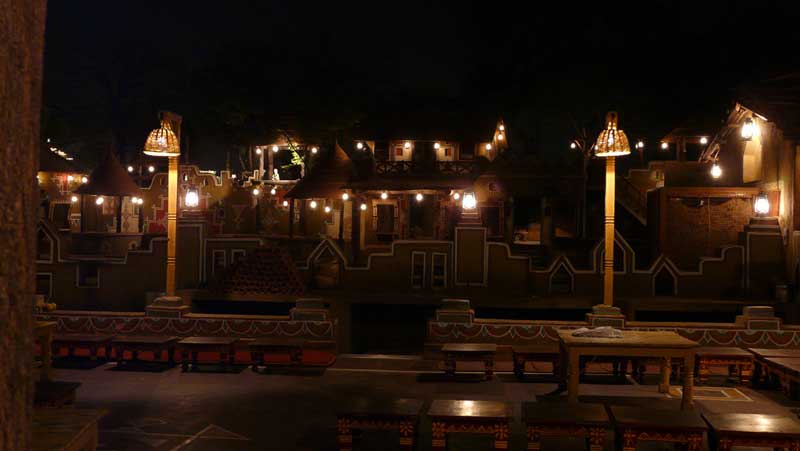 Located approximately 20 kilometers from the pink city, Chokhi Dhani Village resort is a must visit location. The name is a Marwari phrase, which translates to ‘Good Village’ is a great place to discover Rajasthani culture, cuisine and the various attractions that the ancient region is known for. The resort resembles a mock village setting with several attractions such as handicraft making, camel rides, magic shows, Rajasthani folk music, Rajasthani folk dances, Astrology and several rides such as merry go rounds and Ferris wheel. The various delectable items from traditional rajasthani cuisine remain a favorite among the tourists as they are severed with much affection and clarified butter (ghee).
Located approximately 20 kilometers from the pink city, Chokhi Dhani Village resort is a must visit location. The name is a Marwari phrase, which translates to ‘Good Village’ is a great place to discover Rajasthani culture, cuisine and the various attractions that the ancient region is known for. The resort resembles a mock village setting with several attractions such as handicraft making, camel rides, magic shows, Rajasthani folk music, Rajasthani folk dances, Astrology and several rides such as merry go rounds and Ferris wheel. The various delectable items from traditional rajasthani cuisine remain a favorite among the tourists as they are severed with much affection and clarified butter (ghee).
Entry Timings
5:00 pm to 11:00 pm
Entry Fees
- Non-AC Dining: Adult – INR 600 & Children – INR 350
- AC Dining: Adult – INR 800 & Children – INR 500
Photo by Ashwin Kumar, CC BY-SA 2.0
15. Ram Niwas Bag
 Located right before the city entrance through the New Gate or Man Gate, Ram Niwas Bag was constructed by Maharaja Ram Singh of Jaipur during the year 1868. The garden is spread in a massive area of 76 acres and contains several important locations within its perimeter such as Albert Hall Museum, Jaipur Zoological Park, Jaipur Bird Park and Ravindra Rang Manch etc. The gardens are well maintained and are commonly frequented by both locals and tourists. Of these, the most important buildings are the Albert Hall Museum and the Jaipur Zoo. The Jaipur Zoo was built in the 19th century by the ruler Sawai Pratap Singh and contains several exotic animal and bird species such as lions, crocodiles, tigers, hyenas, jackals and leopards along with while peacock, swans and storks etc. The Jaipur Zoo is also famous in the country for its successful Gharial breeding program established in 1999.
Located right before the city entrance through the New Gate or Man Gate, Ram Niwas Bag was constructed by Maharaja Ram Singh of Jaipur during the year 1868. The garden is spread in a massive area of 76 acres and contains several important locations within its perimeter such as Albert Hall Museum, Jaipur Zoological Park, Jaipur Bird Park and Ravindra Rang Manch etc. The gardens are well maintained and are commonly frequented by both locals and tourists. Of these, the most important buildings are the Albert Hall Museum and the Jaipur Zoo. The Jaipur Zoo was built in the 19th century by the ruler Sawai Pratap Singh and contains several exotic animal and bird species such as lions, crocodiles, tigers, hyenas, jackals and leopards along with while peacock, swans and storks etc. The Jaipur Zoo is also famous in the country for its successful Gharial breeding program established in 1999.
Entry Timings
8:00 am to 11.00 pm
Zoo Entry Timings (Closed on Tuesdays)
Summers – 8:30 am to 5:30 pm
Winters – 9:00 am to 5:00 pm
Entry Fee
- Indian Visitors: INR 10
- Foreign Visitors: INR 100
- Free entry for children aged below 5
Photo by Anthropoligist, CC BY-SA 3.0